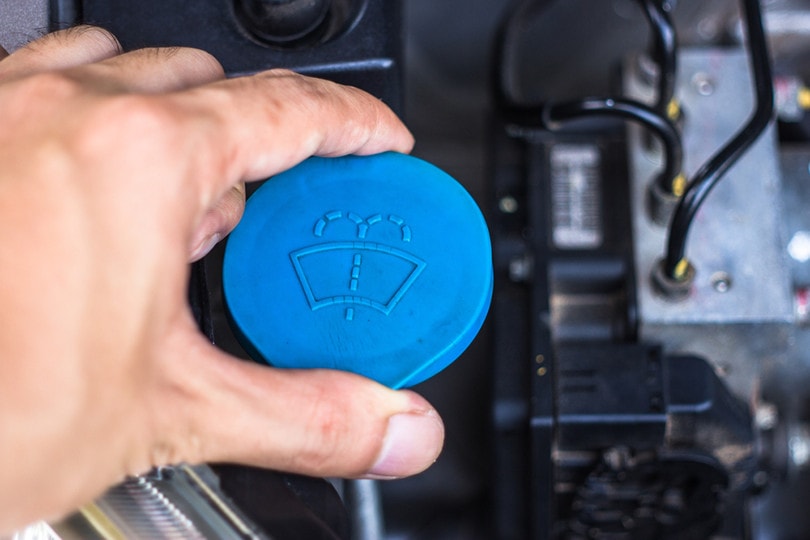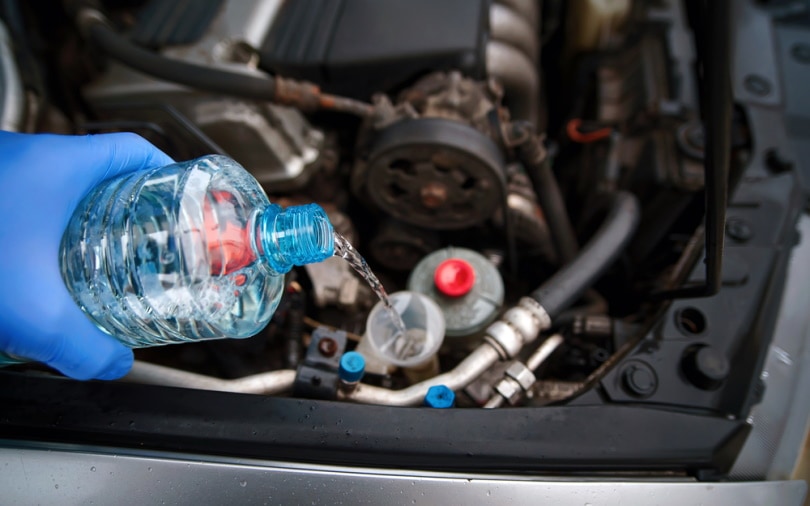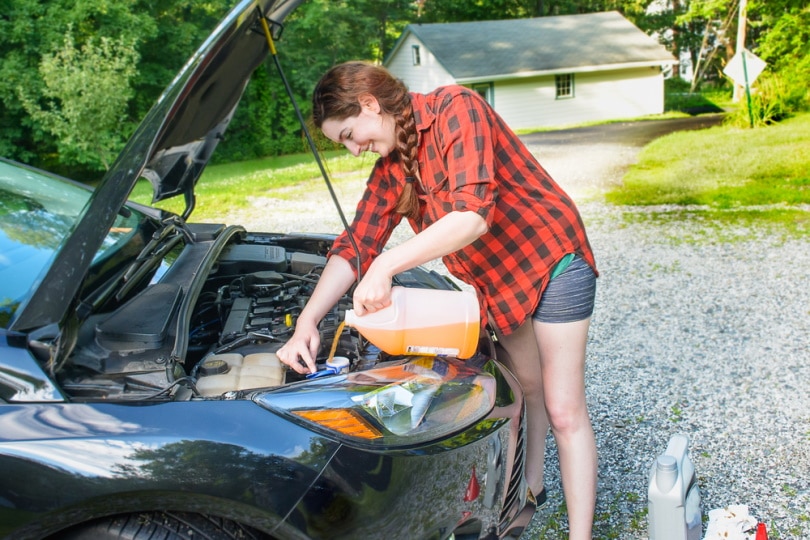Where Do I Put Windshield Wiper Fluid? Facts & FAQ
-
Pete Ortiz
- Last updated:

If you want to keep your vehicle running in good condition for a long time, you know you have to maintain it regularly. Some maintenance requirements, like changing brake pads and oil, are more challenging than others. At the same time, others can go unnoticed because of their mundane nature, like refilling your wiper fluid.
Driving your vehicle with no wiper fluid is seemingly not important to the performance of your car, but can be highly dangerous to you as the driver. Washer fluid helps clean any debris on your windscreen, improving overall visibility. Therefore, a vehicle without wiper fluid can result in situations where the driver is unable to properly see the road and thus unable to drive safely.
Depending on the make, year of manufacturing, and car model, your washer fluid could be located in several places. This article will be a comprehensive guide on putting windshield wiper fluid in your vehicle and everything you need to know about it. Keep reading to learn more.
Where Is the Wiper Fluid Reservoir?
If your car is electric-powered, the reservoir might not be where you expect it to be. Most washer fluid reservoirs are located in the engine bay, near the windshield, and mounted next to the firewall. It is usually marked by a cap with a windscreen and moving wipers symbol. When you open it, you should find a dipstick to help you tell the level of your washer fluid.
However, if you cannot locate it or are uncertain whether the reservoir you’ve picked is the right one, refer to your vehicle owner’s manual for verification.

Determining Your Reservoir’s Washer Fluid Level
To get an accurate reading of your reservoir’s level, it’s essential to park your car on level ground before taking your reading. This will also help you fill your reservoir with the right amount of washer fluid as well as aid in avoiding under or overfilling.
Once you’re confident you’ve located the reservoir, check to see if it has low and high-level indicators on the side. Most are made out of translucent plastic and are clearly visible to where you can tell the water level inside. But if not, it should come with a dipstick to help you tell the level.
Twist or pull the cap gently, ensuring you don’t use too much force to damage the reservoir. Ensure to place it in an open, clean place, where it’s easy to locate. Again, ensure no debris gets on the cap because if it finds its way into your reservoir. It could get sucked into your car’s plumbing and cause a blockage.
In addition, if the cap is damaged or does not fit on the reservoir tightly enough, you should replace it to avoid any issues in the future. Finally, examine the reservoir using either method discussed above and determine if it needs refilling or not.
Refilling the Reservoir with Washer Fluid
Use a funnel on top of your reservoir mouth to help direct the washer fluid and avoid making a mess. Then place the spout of your bottle on top of the funnel and gently pour the washer fluid into the reservoir. Fill it until it reaches the indicated full position on the reservoir and ensure not to overfill it.
Remember that fluids expand when heated, and it goes without saying—the engine bay gets quite toasty! So unless you want your reservoir to crack due to too much pressure and start leaking, we suggest not overfilling it.
In addition, if any liquid gets or sprays on the car while refilling, ensure you wipe it off with a dry cloth or paper towels. This will help you keep everything neat as well as avoid rust build-up.
Finally, take your clean reservoir cap(that’s in good working condition), wipe it down with a clean rag, and screw it back on.
You should also note that if your vehicle has a back windscreen wiper, it might have a separate reservoir. Check to see if it does and repeat the same process.

Test to See If the Washer Is Spraying
Now, get back into your car, start it, and turn on your wipers while spraying the washer fluid to see if it works. If it does, go ahead and turn off your car, ensure your reservoir is appropriately closed, and your engine bay is cleared before shutting the hood.
However, if your washer does not spray, then it could mean your lines or jets are clogged and need clearing or replacing. Your washer may also not spray if you have a defective pump. Either way, try unclogging the jets using a thin wire or a toothpick by agitating any dirt in their openings.
If it does not work, consider taking your car to the shop to have a professional mechanic look at it.
How to Choose Washer Fluid
For your washer fluid to be most effective, it’s essential not just to use water as your cleaning liquid. Water alone in your reservoir can freeze and leave you without washing fluid. In addition, when it’s used on its own, it’s not as effective at cleaning as when mixed with washer fluid.
On the other hand, washer fluid is designed to prevent streaks from forming on your windscreen, which helps preserve visibility. It is also designed to not freeze in cold temperatures. However, if you live in an extremely cold place, you will still need to add antifreeze to prevent your washer fluid from freezing.
There are also washer fluids that contain antifreeze, while others are made of chemical formulas that cause water to bead off the glass when it rains to maximize visibility.
So depending on the conditions you face most in your area, pick the washer fluid that works best for you. After purchasing concentrated washer fluid from your local shop, you may need to dilute it with water before adding it to your car. However, diluting it is simple and only takes a few steps.
You will need to mix it in a 50/50 ratio of water to fluid but ensure to read your specific washer fluids brand guidelines on mixing.

FAQ
How Do You Know Your Windshield Washer Pump is Faulty?
First, try activating the pump by spraying fluid. If you hear it making a sound, it means it’s functioning, and a few spraying attempts will most likely clear any clog. Next, check if your jets are still connected to their hoses. You would be surprised how often they become loose and disconnected. If it is still intact and you turn your washer on, and no sound is heard from the pump, that’s a sign it’s busted.
Are There Separate Reservoirs for Front and Back Windscreen Wipers?
This usually depends on the make and brand of the car. Most use the same front reservoirs, but some do have separate ones.
Can I Just Add Antifreeze to the Existing Washer Fluid in the Reservoir?
Don’t just add antifreeze into your reservoir. It can damage your paint when you spray your windscreen. Instead, buy washer fluid with antifreeze and ensure to mix it correctly with water before adding it to your reservoir. It would also be advised to clear your reservoir of the remaining washer fluid before replenishing it with the one with antifreeze. This will allow you to keep that perfect ratio between water and washer.
In Conclusion
Good vehicle maintenance is essential for your safety and your car’s longevity. It also gives confidence behind the wheel, knowing everything is working correctly. And in the unfortunate event when an accident does happen, you have peace of mind knowing that it was not because of negligence.
Hopefully, after reading this article, filling your wiper fluid will be as easy as putting on your seat belt. So what else would you like us to cover about vehicle maintenance? Let us know in the comments section below.
Featured Image Credit: NOTE OMG, Shutterstock
Contents


